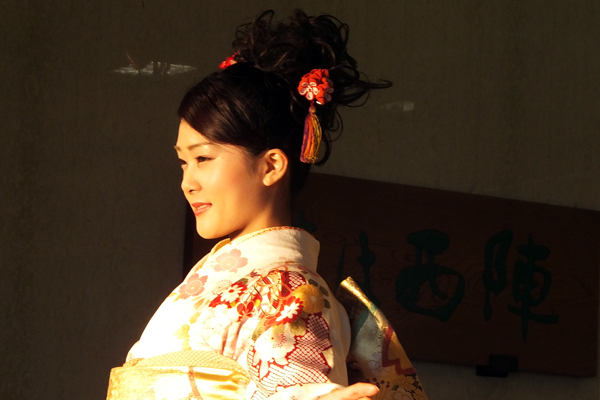Concluding our series taking a look at the lesser known side of neighboring Kyoto and Shiga prefectures – we’ve busted some myths about Japanese beef and the history of the ninja as well as taking a boat ride from the mountains and down into Kyoto as well as explaining why Michelin stars don’t matter to kaiseki chefs, but now it’s time to get on with some kimono ‘cosplay’…
by Matthew Hernon
One of the most enchanting things about a trip to Kyoto is seeing so many people strolling the streets in a kimono. What is already a traditional but vibrant city comes to life as the fabric-clad locals gracefully (if they’ve had a lot of practice!) wander by, and with a history that goes back well over 1,000 years, the traditional garments both men and women wear are as much a part of the region’s cultural heritage as any temple, castle or shrine.
The local government in Kyoto has apparently in the past provided incentives such as free public transportation and entry to tourist attractions for those dressed in kimono, so keen is it that the attire remains a part of daily life rather than become consigned to sporadic ceremonial duties.
For female tourists in particular, the opportunity to ‘dress like a maiko’ or as a lady from the Imperial Court makes any sightseeing experience memorable. And, put simply, when in Kyoto, why not do as the local kimono rental shops allow?
One of the most well-known of these is the Nishijin Textile Center, which offers a wide range of attire-for-hire. A museum, gallery and store all rolled into one, you’ll also learn quite a bit about the process that went into making the garb before you grab it and go pound the streets with new found grace…
“The local government in Kyoto has apparently in the past provided incentives such as free public transportation and entry to tourist attractions for those dressed in kimono”
The most glamorous style seems on our visit to be the Juni-hitoe, a 12-layered kimono that first appeared in the 10th Century of the Heian Period and which was worn only by court ladies in Japan. These days it is rare to see the elaborate dress, even amongst the nobility, though Crown Princess Masako did famously wear the Juni-hitoe on her wedding day, as did Empress Michiko during the enthronement ceremony of Emperor Akihito in 1990.
For guys wanting to get involved, why not try the Sokutai, a complex outfit that was worn by courtiers, aristocrats and the Emperor for special occasions? You can pay up to around 10,000 yen for your kit for the day, but there are cheaper, simpler options; a professional photographer is on site, too, though we’d imagine you’ll be Instagramming your way around the streets anyway…
For tips on how to look graceful in those shots, and while walking in the outfit, you might want to mimic some of the moves on show at the Kimono Fashion Show that takes place seven times a day between 10am and 4pm. Models showcasing Nishijin’s fabrics, and just how to wear them on a mini-walkway, should show you how it’s done – see above!
The Nishijin Spirit
As well as the finished product, visitors can see the kind of efforts the professionals put into their weaving as they show off their techniques on looms scattered around the building at Nishijin.
The amount of time taken to create the elaborate designs we see woven in to kimono fabric is incredibly long, but watching the precise movements for yourself and catching just part of the process is pretty mesmerizing, even if you don’t follow through all the way from yarn to finished piece.
A gift shop sells hand woven fabric as well as various other small items created in the Nishijin spirit; with kimonos, kimono sashes, ties, gold brocade fabric and other paraphernalia, it is quite the haberdasher’s paradise.
A Historical Materials Room gives a fascinating insight into Nishijin’s colourful past, starting around 1,200 years ago, introducing sericulture – the breeding of silkworms – and silk weaving. The economic power of the clan was it’s said one of the main incentives behind Emperor Kanmu’s decision to move the capital to Kyoto.
After that, the Nishijin region started to prosper, serving the Imperial Family and the country’s wealthiest inhabitants during the Heian Period (794-1185). Locals have had problems since, including during the Ōnin War (1467-1477), when the region was destroyed, but they have continued to bounce back and have never sacrificed their traditions or principles in order to make a profit.
Even with all the modern technology available to them, Nishijin weavers still do most of their work by hand, and with artisanal products of this spirit and quality, we wouldn’t have it any other way.










